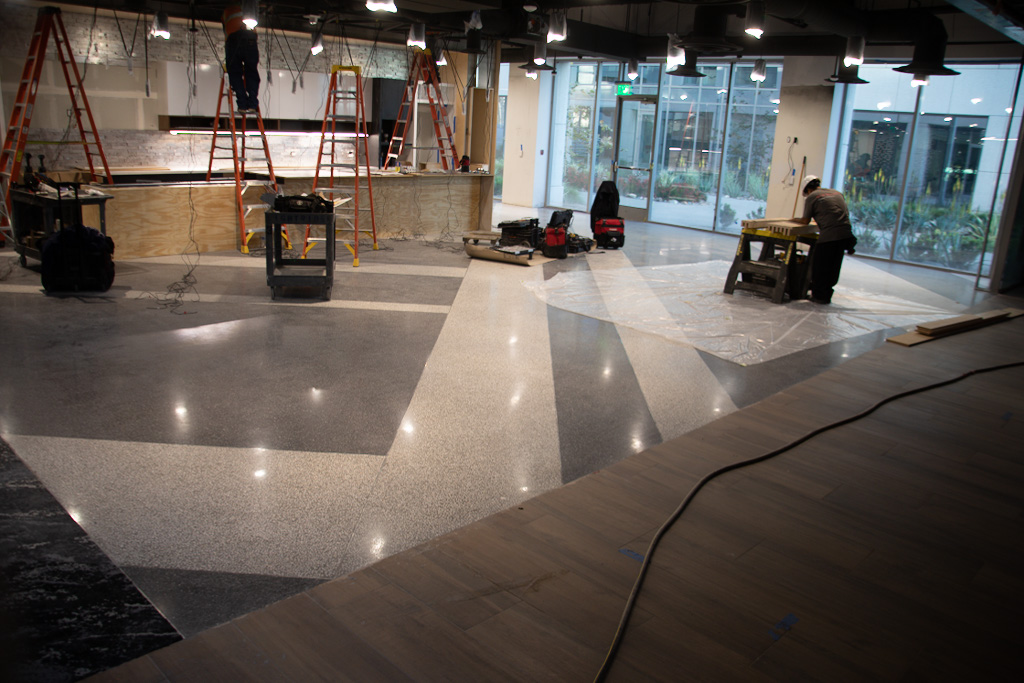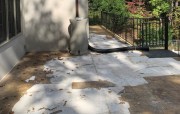Polishable concrete toppings are a popular choice for both damaged floors and new construction. For existing floors, in particular, 3/8-inch bonded-concrete overlays provide a versatile decorative option. Project owners can choose from a variety of colors and aggregates to create unique, multicolored designs, produce a terrazzo look, or match slabs to adjacent flooring.
Contractors often face challenges, though, when asked to produce a uniform appearance in a polished concrete overlay. To achieve consistency in each project, ensure the necessary steps are being taken before grinding and polishing begins.

CTS Cement
Use proper mix proportions to keep aggregate suspended and near the top of the surface,
1. Control the Water in the Mix
The mix can make or break a project. A polished concrete surface should show aggregate consistently. If there’s too much water in the mix, the aggregate will sink and won’t be visible when grinding, resulting in an inconsistent floor. Having one person in charge of both the water and mix station on a jobsite will help. This person should also perform slump tests and be responsible for hitting the desired target. Slump tests are especially important when colorants are being added.
At Total Surface Solution, in Maplewood, N.J., the team begins a project by experimenting with the water ratio until they have the slump they need. “You must be diligent with your water ratios,” says Todd Sherman, founder and CEO. “Once you have determined the water ratio, you must be consistent throughout the project.”
Bottom line: Use proper mix proportions to keep aggregate suspended and near the top of the surface, and be mindful of how much water you’re using.

CTS Cement
Maintain a wet edge when placing an overlay.
2. Limit the Size of Your Work Area
Why pour a 40-foot-wide area when you can pour a 20-foot-wide area and get more consistent results? It makes better sense to align the width of the pour to the production capacity of the mix station. Mix in larger batches (four to five bags) to ensure consistency. Working with larger batches combined with controlling the width of the pour allows you to keep a proper wet edge. Wet material needs to be placed into wet material to avoid cold joints. Then a gauge rake is used perpendicular to the direction in which the material was placed. Nowadays, a spike roller is typically used in the same direction that the material was first placed in order to release trapped air and create an ideal surface for grinding and polishing.
Take, for example, a project for which a contractor would use two large mixers for a 3/8-inch placement. Those two mixers can process 80 to 100 bags per hour, which is enough material for about 1,200 to 1,600 square feet of floor. For that production rate, figure out the best pour width or use additional mixers if the project requires a wider pour.
Bottom line: Mix and place what your mix station can actually produce.
3. Monitor Air Temperature/Movement
Elevated temperatures will reduce your working time. When working in temperatures above 70 F, contractors may need to shorten the width of the pour to keep a wet edge. When pouring indoors, climate-controlled buildings can keep temperatures consistent. The concern then becomes eliminating air movement. Self-leveling concrete dries from the top down, so it’s essential to ensure fans are not blowing to avoid cracking due to premature drying.
During pouring and curing, it’s important to adhere to the instructions for the cement. “We use CTS Rapid Set products and they provide detailed specifications for their products, which helps the process,” Sherman says.
Bottom line: Compensate for warmer temperatures and block air movement for better results.

CTS Cement
Keep the same workers at each mixing station to maintain consistency.
The Polishing Crew Will Know
During the first step of the grinding stage, a polishing contractor can tell if the mixing and placement was done correctly. If the aggregate isn’t uniformly distributed in the overlay material, the polishing contractor may have to do multiple passes with the initial grinding steps to make it look uniform. Using the right material is important—and watch the water ratios.
“Consistency in our mixes throughout our projects is very important to us,” Sherman says. “Recently, on a large job, we had to use different lots but the mix was still consistent from batch to batch. My team finds it’s easy to achieve consistent results with the Rapid Set TRU flooring products—there’s no guesswork involved to ensure the mix is correct.”
Installing a healthy polished concrete overlay is all about adhering to the recipe. Don’t let too much water ruin the mix and don’t place material in wider strips than your mix station can produce. Contractors who pay attention to these details will achieve the finishes that their customers demand.



